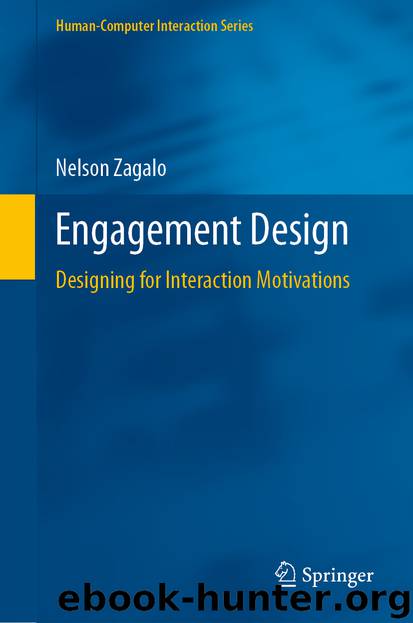Engagement Design by Nelson Zagalo

Author:Nelson Zagalo
Language: eng
Format: epub
ISBN: 9783030370855
Publisher: Springer International Publishing
4.3.3 Comparability/Relatedness
Unlike uncertainty and novelty , which by focusing on problem-solving and creativity contexts operate on more accessible and potentially stable external information, information about humans is “extraordinarily complex” (Fiske, 1995), given the need to access private and subjective experiences —in their behaviour, thoughts and feelings—that make information less easily accessible and at the same time less reliable. For this purpose, “interpersonal curiosity ” (Litman & Pezzo, 2007) is a fundamental behaviour that guarantees the activation of the search for knowledge about others, being strongly motivated by the volition of “social comparison” (Festinger, 1954).
Without strong knowledge of each other, it is not possible to guarantee the creation of affiliation processes between people. Family ties foster an intrinsic basis of closeness and relationship (Bowlby, 1988) that cannot be replicated by mere affiliation groups due to lack of biological relationship, forcing the continued comparative processes between us and the others, searching to identify affinities and sympathies. These comparative processes do not serve only to understand others, they are also fundamental in understanding ourselves (Dunning & Hayes, 1996) and this perspective intensifies through Mead’s symbolic interactionism (Mead, 1982) which argues that we exist only insofar as we socially interact with others. That is, our individuality depends on the common symbolic aspects that occur in the interaction with other individual beings. From this relationship emanates a set of shared references that allow each of us to understand the contexts in which we are inserted, the others and ourselves.
This same approach was deepened through Bandura’s “theory of social learning” (Bandura, 1962), which argued empirically, that human beings learn essentially by imitating each other. Working on the social relationship, the subjects observe and compare in order to create their own behavioural models of action in the world. These same models can be amplified not only by behaviourist punishment and gratification, but by visualizing these processes in others, that is, through imitation learning or mere observation, which Bandura refers to as “enactive” or “vicarious” (Bandura, 1977). The case of enactivity is fundamental in the field of “tacit knowledge” (Polanyi, 1966), knowledge that cannot be described, which we access only by visualizing others doing and imitating, learning by doing—e.g. cycling or surfing. For Varela, Rosch and Thompson, the enactivism goes beyond the mere imitation and:emphasize the growing conviction that cognition is not the representation of a pre-given world by a pre-given mind but is rather the enactment of a world and a mind on the basis of a history of the variety of actions that a being in the world performs. (Varela, Rosch, & Thompson, 1991, p. 9)
Download
This site does not store any files on its server. We only index and link to content provided by other sites. Please contact the content providers to delete copyright contents if any and email us, we'll remove relevant links or contents immediately.
Sass and Compass in Action by Wynn Netherland Nathan Weizenbaum Chris Eppstein Brandon Mathis(7915)
Autodesk Civil 3D 2024 from Start to Finish by Stephen Walz Tony Sabat(7124)
Mathematics for Game Programming and Computer Graphics by Penny de Byl(7045)
Taking Blender to the Next Level by Ruan Lotter(6838)
Express Your Creativity with Adobe Express by Rosie Sue(6642)
Hands-On Unity 2022 Game Development - Third Edition by Nicolas Alejandro Borromeo(6250)
Hands-On Unity 2022 Game Development by Nicolas Alejandro Borromeo(5070)
Unreal Engine 5 Character Creation, Animation, and Cinematics by Henk Venter & Wilhelm Ogterop(3962)
Going the Distance with Babylon.js by Josh Elster(3923)
Squeaky Clean Topology in Blender by Michael Steppig(3805)
Mastering Graphics Programming with Vulkan by Marco Castorina & Gabriel Sassone(3803)
Adobe Illustrator for Creative Professionals by Clint Balsar(3737)
Drawing Shortcuts: Developing Quick Drawing Skills Using Today's Technology by Leggitt Jim(2960)
Unreal Engine 5 Character Creation, Animation, and Cinematics by Henk Venter Wilhelm Ogterop(2909)
Rapid Viz: A New Method for the Rapid Visualization of Ideas by Kurt Hanks & Larry Belliston(2793)
The 46 Rules of Genius: An Innovator's Guide to Creativity (Voices That Matter) by Marty Neumeier(2723)
Learn Qt 5: Build modern, responsive cross-platform desktop applications with Qt, C++, and QML by Nicholas Sherriff(2396)
Fusion 360 for Makers by Lydia Sloan Cline(2262)
Hands-On Neural Networks with Keras by Niloy Purkait(2209)
